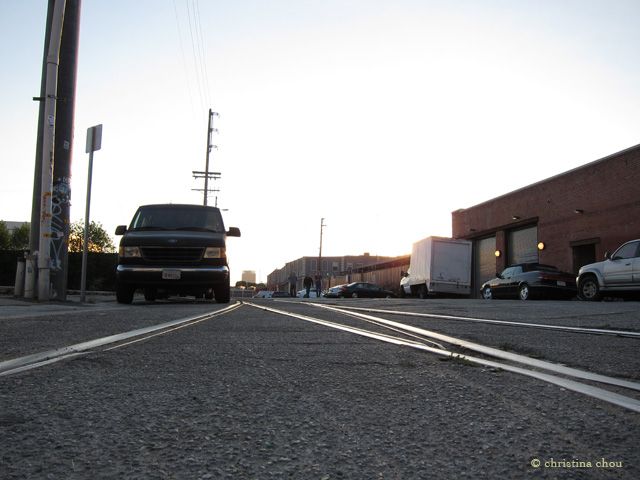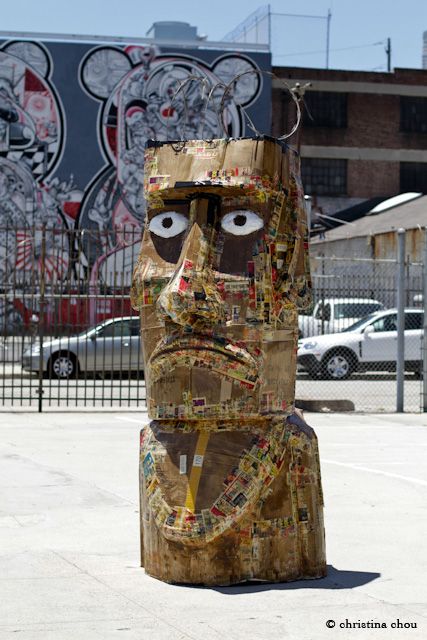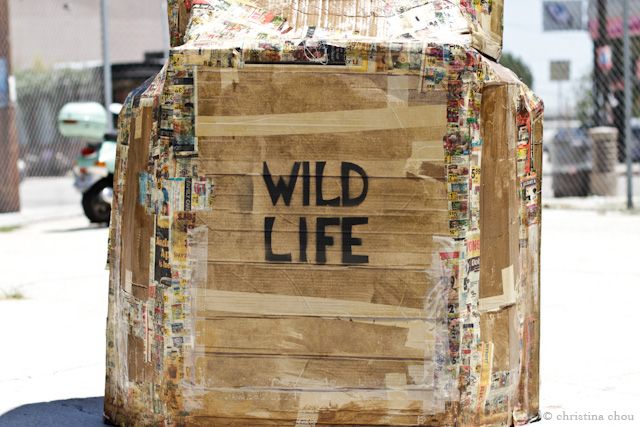Last-Minute NYC Holiday Gift Guide 🎁
We’ve created a holiday gift guide with presents for the intrepid New Yorker that should arrive just in time—


In April of 2009, Los Angeles Mayor Antonio Villaraigosa announced the launch of Clean Tech LA, a collaborative effort of the Los Angeles Business Council, the Economic Development Corporation, the Chamber of Commerce and the city’s research universities, to foster a breeding ground for companies looking to develop businesses in green technology.
The vision’s physical manifestation culminated in plans for the Los Angeles Clean Tech Corridor in the heart of the historic warehouse district, with utopian artist renderings of futuristic, glittering, energy-efficient buildings and proposals for eco-friendly green spaces.
Three years later, a dusty vacant lot sits at the site where La Kretz Innovation Campus of the Los Angeles Clean Tech Incubator (LACI) is meant to stand (the block-long campus is set to open summer 2013). But despite delayed development and a seemingly slow start, Los Angeles and its Clean Tech Corridor have more to offer than meets the eye.

WHY LOS ANGELES?
Jon Miller, Chief Technical Officer of Hive Lighting, meets me at his office in the temporary LACI building on Hewitt Street in Downtown. Hive is one of the portfolio companies housed at the Incubator, which provides affordable workspace for green startups and connects them with business mentorship and potential investors. We walk less than a block down Hewitt to the ultra urban chic Urth Caffe to grab coffee and discuss the less-than-obvious relationship between the Los Angeles Arts District and the burgeoning Clean Tech Corridor.
The first thing Miller points out is something we rarely think about: that Los Angeles has history. In the epicenter of “the next best thing,” particularly in the warehouse-turned-arts district, lies a rich core knowledge – the necessary know-how and equipment – for technology development based on the aerospace, shipping, automobile, and manufacturing industries that have called the city home over the years.
Combine that manufacturing legacy with research universities like Cal Tech, UCLA, and USC, the creative talents of nearby Southern California Institute of Architecture (SCI-Arc), and a favorable, resource-rich business environment, and suddenly Los Angeles seems like a more natural fit for something like the Clean Tech Corridor.

There are other considerations, too: Los Angeles’s large available market for emerging technologies, its premiere status as an exporter of both goods and popular culture, its pioneering exploits in new media, its growing fine arts community and thriving gallery scene, and perhaps the most – or least – obvious: its geography.
“Los Angeles is a great place to work on efficiency questions when it comes to air quality, transit, and new renewable energy sources like solar and wind – are all really available in southern California,” explains Miller. Plus, he says, “it’s a perfect place to test out more efficient cars, because it’s one of the largest urban centers for cars. The 405 freeway is one of the most crowded freeways in the world.”
And then there’s Hollywood. The film industry, he says, enjoys a similar tradition of technology and innovation, with technically skilled manufacturers figuring out ways to build the tools – cranes, steady cams, new rigs – directors need to shoot and create the films they want.
“In the end, if you have a strong manufacturing base, it feeds into most artistic pursuits,” says Miller. “There’s a place where manufacturing and the artistic community meets in [the form] of artisanal craft. To me it seems very logical.”

Which is where Hive Lighting comes in. Two years ago, Miller, who was working in Los Angeles as a cinematographer and photographer, and his college friend Robert Rutherford – an experienced salesperson in the lighting industry – stumbled upon plasma bulbs, a new and energy-efficient technology on display at a local lighting fair (yes, there is such a thing). Plasma bulbs were already being used for highway street lamps, horticulture and aquariums. But to their surprise, nobody had yet developed fixtures for application in the entertainment and arts industries.
As a filmmaker, Miller was immediately intrigued by the possibilities plasma bulbs could have for his own work. But he and Rutherford soon realized that creating such a fixture would cost money, which meant renting their lights out, which in turn meant starting their own company to design and manufacture the housing and optical systems for the purpose of “image capture” – in laymen’s terms: lighting for film, television and photography.
Their third partner, Jaime Emmanuelli, joined the team about a year later and brought with him over 25 years of sales and marketing experience in film lighting and manufacturing. Now a year and a half after incorporating, they’ve built prototypes, tested the waters on 25 to 30 film productions, debuted their products at the National Association of Broadcasters Convention, and are now in the middle of their first production run (scheduled to begin shipping in mid-July).
“Basically we make tools for artists,” says Miller. “I come from a world where these tools are being used. So it was really important to me that we create products that artists and filmmakers can use.”

The most significant factor is the quality of light. Hive products have a superior color-rendering index and a fuller spectrum of light than normal bulbs, so filmmakers and photographers can more closely simulate natural sunlight and capture a more accurate rendering of color and detail for their images. Plasma lighting runs silent and is flicker free, allowing for the faster frame rates and shutter speeds needed for action scenes and slow motion effects.
“That’s been an important thing that LACI has worked on with all of its incubating companies – making sure that you’re creating products that are solving problems. They’re not just green, they’re good products solving real problems in the Los Angeles area, and part of the benefit is that they offer energy savings. Because energy savings is really cost savings for most people, and that’s what’s really huge,” says Miller.
“A lot [times] you’ll have something that’s efficient but not very useful. People often resist taking on green technology because it’s not the same quality,” he says. “The problem is that for most people – especially filmmakers – their number one pain point is not global warming. It’s getting their job done. It’s creating their piece of work.”
“It’s not that they don’t care about those things, it’s just that in the end, if the tool doesn’t get the job done, they can’t use it no matter how much they’d like to be green or environmentally-conscious.”
Although the team emphasizes lighting quality, Miller says, “We are inherently about energy efficiency, so we are a Clean Tech company.”
Because Hive products use two to seven times less power than existing technologies to create the same amount of light, the lights can be run off batteries instead of costly, bulky and environmentally taxing diesel generators. Additionally, the bulb life for plasma lights is 10,000 hours compared to 250 to 1,000 for regular bulbs. According to Miller, about 80 percent of power used on a film set goes into lighting, so lower electrical costs, fewer petroleum products, and less waste all translate into savings.
Whether you’re a major movie studio with a green initiative or an indie filmmaker trying to do a lot with very little, says Miller, “In the end, the only way that sustainability really works is when sustainability makes financial sense and makes it easier to do the job at hand.”
“At the heart of what Hive wants to do is create the tools for filmmakers that allow them to make better movies and allow them to make the movies they want to make,” says Miller. “If you can cut [lighting costs] in half, that’s a real savings opportunity for the production. That hopefully means you can have another day of shooting, you can have another location, you can have more crew where you need it. Hopefully that’s money that can be put into the story.”
“We want you to believe in it, but we also want to make sure that our product makes sense for your business,” he says.

THE CLEANTECH CORRIDOR: WHERE ART AND TECHNOLOGY CONVERGE
As one of LACI’s incubating companies located in the heart of the arts district, Miller’s work with Hive Lighting has put him right at the intersection of art and new technology’s confluence within the Clean Tech Corridor – and the new community germinating there.
Being part of LACI exposes Miller and the Hive team to others who are working toward the same goal: how to bring energy efficiency to Los Angeles through practical and varied applications. But besides their close proximity to fellow LACI portfolio companies, Hive’s location has a particularly strategic competitive advantage for their business: it puts them within striking distance of their main customer base.
Over the last 40 years or so, the abandoned toy factories, food processing plants, rail yards, and cold storage buildings of the warehouse district have been converted into loft spaces – and a full-fledged community – by enterprising artists looking for a place to live and work. So there are plenty of photo and film studios where they can test Hive Lighting products and get direct feedback from potential customers working in real studio spaces.
“[Being in the arts district] allows me to be going to gallery shows, to MOCA openings, to films screening downtown,” he says. “I still feel very connected to the artistic community that I was apart of before I started this company.”
“What’s really important for us is that we’re making tools for filmmakers, so we need to know what they’re doing, we need to know what they need. We can’t really lose touch with that base, because then we lose touch with our core customer. It’s very important that we stay connected to how they’re working and what they’re working on. So we try and visit sets as often as possible and be in constant contact with filmmakers,” he says.
For Miller, being part of the community is more than mixing and mingling with other artists, but also participating in the creative process.
“As an artist – as a filmmaker – what I always loved doing was making things. And there is a lot of that in designing and making products,” says Miller. “What’s exciting about being a manufacturing company is there is still craftsmanship and working with materials. Fabrication is a big part of the artistic community, and it’s part of manufacturing.”
According to Miller, the two communities – artistic and Clean Tech – have a lot in common. Like entrepreneurs working in new technology, artists are inherently people who are very conscious about the world around them.
“They’re always curious about innovation and what’s new – the idea of the avant-garde, of being on the cutting edge of things,” he says. “Fundamentally, it’s two different communities that are asking, ‘How can we see the world in a different way?’ Both have made it a point to look at the way the world works now and challenge that.”

For those starting Clean Tech companies, he says, “You’re trying to say, ‘This is the way the world works as I understand it. How can I make it work in a way that’s better? Can I make it more efficient? Can I make it use a different power source? Can I combine those things? How can we waste less, produce more?’
Artists and entrepreneurs also face many of the same challenges that go beyond the long hours and issues of cash flow, money management, and invoicing.
“You have to have faith that your vision of where this is going and what it can be is worth all of the time and effort and pain and suffering that goes into it,” says Miller. “You hope for a reward in the end, but you kind of have to love the process.”
“It’s a community where people have to be self-starters. Where they have to say, ‘Alright, I have this idea and I believe in it, and I can’t wait for anyone else to tell me it’s a good idea.’ I think that’s really important for entrepreneurs and for artists, because otherwise you’ll never get anywhere – if you wait for people to approve of it.”
“Something that’s really interesting about Los Angeles is that most people are balancing their creative work with some of their professional work,” says Miller. Clean printing on recycled materials and designing graphics, or printing t-shirts and playing in a band. The film industry, he says, is no exception: nearly everyone who services the film industry is also creative, whether they’re fabricating props or designing lighting for photography.
“I feel like we’re constantly meeting people like that. They’re channeling a lot of their creative efforts into both their company and their creative outlets. I think I’m constantly surrounded by that,” he says.
It’s that sense of shared community and its role in their company that prompted Hive to keep design and assembly in Los Angeles; nearly all of their components are from manufacturers within the States, and whenever possible, California.
“It’s very important to us because of the communities we work in, and because we come from [a background of] fabricators and freelancers who work here in the United States. And it’s also a quality control thing; we want to be able to respond quickly to the needs of our consumers,” explains Miller.
Eventually, he says, Hive would like to export their core technology to the rest of the world, with huge international markets for filmmaking – and thus lighting – in places like Bollywood, China and elsewhere.
But for now, says Miller, “It’s been really exciting to combine Hollywood – the core business that LA has always had – with clean technology. It’s a really nice marriage of the old and new that defines people’s image of Los Angeles.”

Get in touch with the author @lynnettewoo.
Subscribe to our newsletter